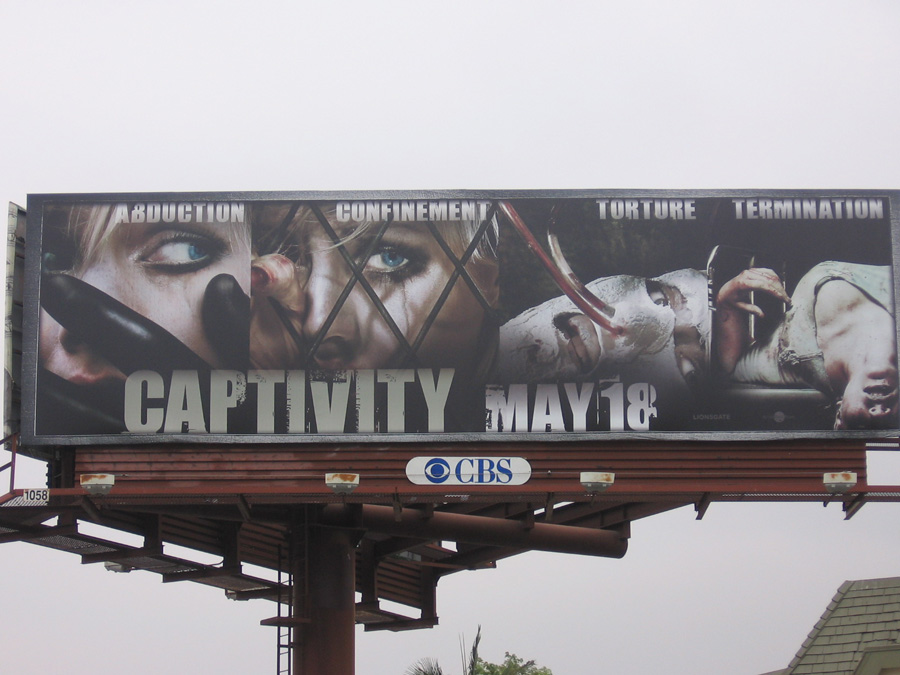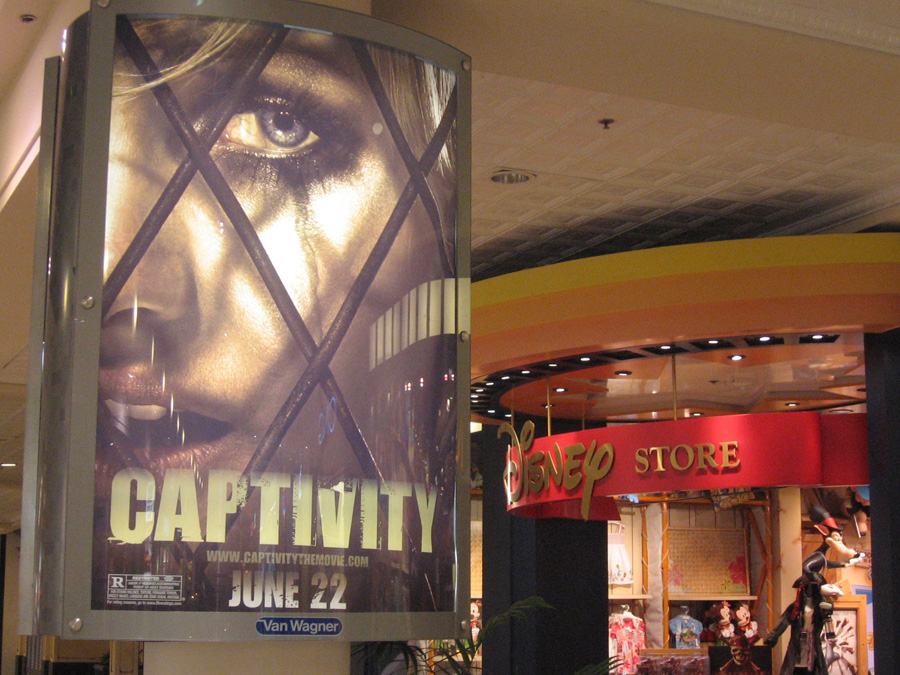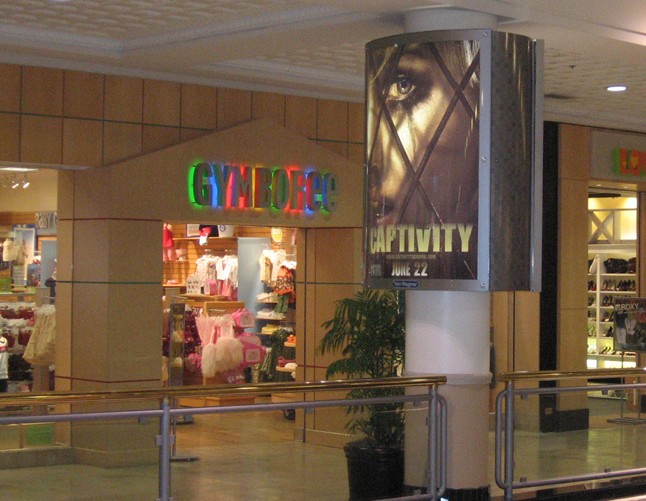Matt C. snapped some pictures of the advertising campaign for the movie Captivity (2007) in Los Angeles. According to this billboard, it’s about abduction, confinement, torture, and termination:

What Matt found interesting was that some of this advertising was placed immediately outside of stores that cater to small children and their parents. Check it out:


Does this suggest to you that we have become so desensitized to violent imagery that no one thinks to, or is empowered to, object when such images are placed at the entrance to children’s spaces? Or, is the image in question considered tame compared with other imagery we regularly consume (the billboard, for example) and, therefore, unremarkable?
More pictures on Matt’s blog.
—————————
Lisa Wade is a professor of sociology at Occidental College. You can follow her on Twitter and Facebook.

Comments 25
julian — August 17, 2009
Both.
"Eh, crying woman behind bars. So what? It's not like they're people or anything!"
Hilary — August 17, 2009
Maybe this is because I don't have kids, but I'm much less concerned about it being near a toy store than the fact that such images are acceptable at all and considered an exciting, "edgy" way to market a movie. And of course the fact that movies glorifying violence against women are so common (if the there were images of victims of both genders equally it wouldn't be so alarming, it's the consistent targeting of one gender that is scary).
zhaf — August 17, 2009
I feel uncomfortable calling a store that markets to children and their parents as "children's spaces."
A store that profits by appealing to children who have not developed the critical thinking ability to judge the nature of those appeals is also objectionable, albeit for different reasons.
Only money really matters to a business and the dollar is its only morality. Money made through images of extreme movie violence or through commercials targeted to children isn't all different to me. Both are objectionable and neither, to me, is unexpected.
I am not sure my complaining would change any of this, unless there somehow was a very broad social movement in our society that ultimately changed our culture.
Meredith — August 17, 2009
Personally, I'm more shocked at how sexualized these images are. I mean, I guess I'm not shocked, since we all live with this kind of thing everyday, but I do notice it. Abduction, capture, torture and killing of a woman is made to look sexy. I find that disturbing. Even in the torture photo, where her face is bandaged, her mouth is open in a sexual pose. I worry as much about teaching children that violence against women is sexy as much as I worry about desensitizing them to it.
Sean Bonner — August 17, 2009
You are aware this happened 2 years ago right?
That movie was released in 2007 and due to the public uproar many of the advertisements were removed, which some folks have speculated was all part of the marketing plan.
Matt Cornell — August 17, 2009
@Sean- Yeah, this happened 2 years ago. But when the studio was forced to pull the billboards, they came up with the "tamer" poster campaign. The media, however, didn't notice that the placement of said posters was often unfortunate to say the least.
Sean Bonner — August 17, 2009
@Matt I don't know about that, being a Blogger based in Los Angeles the placement was something I heard about quite vocally from many folks. The argument was that no "new" signs were put up for this campaign, they just bought existing movie marking spots which are frequently targeted to children, when everyone notices what the campaign was for and about people flipped out and it got changed, but like I said the speculation is that the PR company behind it was anticipating that freak out to help with their marketing plan.
Matt Cornell — August 17, 2009
@Sean- The placement of the initial (banned) billboards made a stink, per the Defamer and LA Times links on my site. But I don't remember any bloggers commenting on the subsequent wave of posters, some of which I spotted at Westside Pavillion. If they did, that's great! I just thought they should be photographed. As a fellow Angeleno you probably know that public advertising featuring eroticized violence is de rigeur for Hollywood. The Captivity campaign is still the most extraordinary example I've seen.
Rose — August 17, 2009
If they're in a mall I doubt it makes a whole lot of difference whether they're outside the Disney store or two shops further down. It's not like it's inside the shop.
But I agree, I don't think these should have been published at all.
maria — August 17, 2009
so... people are (were) pissed and indignant about a movie poster featuring a woman in "captivity"... posted in front of a store owned by a company who built their entire multi-billion dollar empire on damsels in distress.
hi there pot, have you met kettle?
Matt Cornell — August 17, 2009
@ Maria- Can't say I was "indignant" about anything, though I share your general antipathy toward gender roles in Disney films.
I was creeped out by the ad campaign wherever I saw it. And I found it particularly ironic to see it juxtaposed with businesses catering to children. Here's an even more bizarre placement.
http://mattcornell.org/imagelink.php?captivity/surfsup.jpg
Coco — August 17, 2009
I remember both the billboards and the public outcry that they were met with when first displayed. To say, therefore, "that we have become so desensitized to violent imagery that no one thinks to, or is empowered to, object when such images are placed at the entrance to children’s spaces" is a bit disingenuous. Indeed, the backlash was acute enough that the relevant production companies (Lions Gate and After Dark Films) both scrambled to disavow the original ads (I recall at least one claim that the wrong ad was sent to the printer -- ha!). When the substitute ads (seen in the interior shots) were released, a second wave of criticism also followed exactly along the lines that the replacement was little improved from the originals.
I love that this made it to Soc Images even long after the fact (it really was an egregious campaign), but let's not pretend that people have less agency or capacity for resistance than they actually do.
LGreenberg — August 17, 2009
The NYC subways are full of really gross posters for horror movies (easily, this gross, maybe grosser), and kids pass by them a million times a day. No one I've pointed this out to had ever thought about it before. So yes, I think we're pretty desensitized to it.
LGreenberg — August 17, 2009
The NYC subways are full of really gross posters for horror movies (easily this gross, maybe grosser), and kids pass by them a million times a day. No one I've pointed this out to had ever thought about it before. So yes, I think we're pretty desensitized to it.
lex — August 18, 2009
@ Coco : "To say, therefore, “that we have become so desensitized to violent imagery that no one thinks to, or is empowered to, object when such images are placed at the entrance to children’s spaces” is a bit disingenuous."
If you read the post, that was a question, presumably for the purposes of discussion - not a statement.
Anonymous — August 20, 2009
It's funny that people get so scandalized when seeing an image like that. I completely agree, that we've become desensitized to these sort of things; violence is more common as the days go by. No child has never heard of an assassination, a rape, etc., they know now about these things and find them probably more normal than those of us that grew up no more than just ten years back.
Yet, still, I'll remark something I find a rather funny anecdote. In South America (leave aside all thoughts of Third World), there are fairs where they sell porn DVD's right next to the children ones. Whilst I hade no clue about anal sex when I was ten, my sister had her own knowledge by that same age, thanks to the cover of a "peculiar" Snow White and the Seven Dwarfs:) This is our Hyper Modern world:)
Keeley — August 21, 2009
AS to the placement of the ads in malls: those look like the kind of posters that go in malls that actually have theatres inside them. The posters are put up by the kids who work there (so we're talking 15 to 17 year-olds who likely aren't paying that much attention to poster/store agreement).
Peržiūrėkite „nelaisvę“ po 18 metų - 8filmaionline.lt – — July 17, 2025
[…] Tuomet visuomenės IRE sukėlė reklaminę kampaniją, kuri stebėjo, kad nerimą kelia. Tikėtina „Pagrobimas, uždarymas, kankinimas, nutraukimas“ „Billboard“ skelbimas. Net tas vienas plakatas Nelaisvė švinas Elisha Cuthbert (Vaško […]